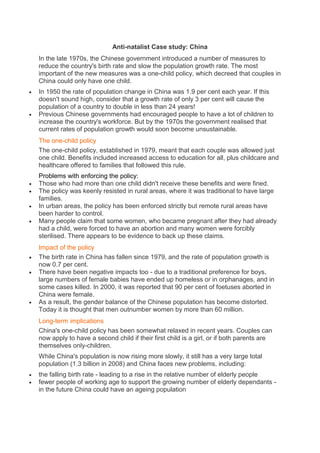
China's One-Child Policy: Anti-Natalist Case Study
- 1. Anti-natalist Case study: China In the late 1970s, the Chinese government introduced a number of measures to reduce the country's birth rate and slow the population growth rate. The most important of the new measures was a one-child policy, which decreed that couples in China could only have one child. In 1950 the rate of population change in China was 1.9 per cent each year. If this doesn't sound high, consider that a growth rate of only 3 per cent will cause the population of a country to double in less than 24 years! Previous Chinese governments had encouraged people to have a lot of children to increase the country's workforce. But by the 1970s the government realised that current rates of population growth would soon become unsustainable. The one-child policy The one-child policy, established in 1979, meant that each couple was allowed just one child. Benefits included increased access to education for all, plus childcare and healthcare offered to families that followed this rule. Problems with enforcing the policy: Those who had more than one child didn't receive these benefits and were fined. The policy was keenly resisted in rural areas, where it was traditional to have large families. In urban areas, the policy has been enforced strictly but remote rural areas have been harder to control. Many people claim that some women, who became pregnant after they had already had a child, were forced to have an abortion and many women were forcibly sterilised. There appears to be evidence to back up these claims. Impact of the policy The birth rate in China has fallen since 1979, and the rate of population growth is now 0.7 per cent. There have been negative impacts too - due to a traditional preference for boys, large numbers of female babies have ended up homeless or in orphanages, and in some cases killed. In 2000, it was reported that 90 per cent of foetuses aborted in China were female. As a result, the gender balance of the Chinese population has become distorted. Today it is thought that men outnumber women by more than 60 million. Long-term implications China's one-child policy has been somewhat relaxed in recent years. Couples can now apply to have a second child if their first child is a girl, or if both parents are themselves only-children. While China's population is now rising more slowly, it still has a very large total population (1.3 billion in 2008) and China faces new problems, including: the falling birth rate - leading to a rise in the relative number of elderly people fewer people of working age to support the growing number of elderly dependants - in the future China could have an ageing population
- 2. The state offered inducements for having only one child such as; Free education Priority housing Pension Child care Family benefits They also had a rigorous range of punishments if the on child rule was flouted (which it clearly was, look at the fertility graph, it never reaches 1!) including; Losing all of the benefits listed above Fines of up to 15% of the family’s income In addition, couples could only marry at 22 for a man and 20 for a woman, and had to apply to the state for permission to first marry and then have a child. This reduces the reproductive “lifespan” of that couple. The policy courted lots of controversy, and China’s imbalance in male to female ratio is evident in the figures about China’s population. It was claimed in the South China post that once couples knew the sex of a baby some would abort if it was a girl. This is known as female infanticide. This is because the Chinese value males in their society more than females because they carry the family name. It has been documented that some women were forced into having abortions if they conceived a second child, and persistent offenders were offered sterilisation. The local factories and communities also had the granny police – who monitored and spied on prospective mothers. This policy was not enforced in the same manner across China, and in some areas it was possible to have more than one child, particularly in rural areas where children were needed to work on farmers. This policy has had huge social ramifications for China – yes it has reduced the population growth, but there have been many secondary problems emanate from the policy. One, it has led to the phenomenon of “Little Emperors”, spoilt single children who get everything they want! It has also destroyed some family way of life, no brothers or sisters, no Aunts and Uncles. It also has future ramifications for China’s dependency ratio – one single child to look after 2 elderly grandparents! This means that many Chinese simply don’t work in the formal economy but work to look after their ageing parents. This means that they are not contributing to the economy and in the past China has relaxed the one child rule. In certain cities today it has been completely abandoned as cities search for economic growth and a workforce that can supply it in the future. The last impact has been to create an army of bachelors, competing for the lower number of females available.
